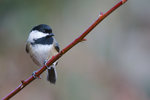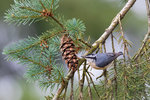


Everyone loves chickadees. They’re handsome, active little birds and readily visit bird feeders in the winter. And they sing their name, “chick-a-dee, dee, dee” as if introducing themselves to their neighbors.
There are two species of chickadees common in our county, and their names help to identify them. The first is the Black-capped Chickadee. It has white cheeks that separate its black head from a black bib. It also has a white belly and is otherwise a buffy grey. It doesn’t really have a preferred habitat – you might find it almost anywhere.
The second is the Chestnut-backed Chickadee. Instead of being mostly grey, this chickadee’s back and sides are a rich chestnut brown. The color difference between the two species is distinct and easy to see. The “chick-a-dee” call also differs between the two species, with the chest-sided sounding more “zee-zee” than “dee-dee.” This species seems to prefer conifer trees, but really might be found anywhere that is wooded.
These birds have a varied diet. Despite their small stubby bills, they readily crack and eat seeds. They also are insect catchers and spider hunters. You might see them cruising along corners of your windows eating spider egg masses. The sexes of both species are identical (although I’m sure they can tell the difference) and both species behave alike. They occur in small flocks that may be family groups. In summer they like to visit bird baths, both for a drink and to bathe. Last summer I had a group of four chickadee fledglings visiting my bird bath regularly.
Closely related to the chickadees, and with similar habits, are the Nuthatches. There are two species in our area, the Red-breasted Nuthatch and the White-breasted Nuthatch.
Like chickadees, Nuthatches are small birds – 4 ½” or so. They have a slim upturned bill and their sides are more orangish than red. They have a black line through the eye with a white eyebrow above. You might see these birds up close because in winter, they come down from the trees to visit feeders; they also visit bird baths. The chickadees and nuthatches are cavity-nesting birds and will use a nest box if it is placed in a suitable location.
You might recall in an earlier column, I mentioned that humans can attract some birds’ attention by making “pish pish” sounds to call in birds for a close look. The chickadees and nuthatches respond to this alarm and sometimes will come quite close to inquire what all the fuss is about. Sometimes the result can be quite amazing.
A similar small species is the Brown Creeper. However, this bird looks and behaves very differently. Again, the common name says it all. These birds are about 5”, but look smaller, and are almost always seen creeping up tree trunks looking for insect prey. You might initially think “woodpecker,” but these birds are smaller and more active. You might encounter them almost anywhere there are good-sized trees. Their brownish-streaked body does make for good camouflage, but their active movements give them away. They have high-pitched, wispy vocalizations and are unique among small birds in their ability to grip a tree trunk with their feet and climb up, down and sideways.
The Bushtit family superficially resembles chickadees, but they are smaller and more dainty. They are tiny greyish birds, 4” or so, with tiny, pointed bills. They are always found in chatty family groups (it’s almost impossible to see a single Bushtit). They range through a wide variety of habitats. They build hanging pocket nests of woven materials. These are sometimes described as “family” nests because one female lays and incubates the eggs, and then the entire family raises them. These nests are not hidden; you might encounter one along a wooded trail, sometimes right at eye height.
George Walter is the environmental program manager at the Nisqually Indian Tribe’s natural resources department; he also has a 40+ year interest in bird watching. He may be reached at george@theJOLTnews.com
Photos for this column are provided by Liam Hutcheson, a 14-year-old Olympia-area birder and avid photographer.
CORRECTION: June 8, 2022 -- A previous version of this story referred to the Chestnut-backed Chickadee incorrectly. We regret the error.
5 comments on this item Please log in to comment by clicking here
Drutty
Today enjoyed hearing a House Finch and it's varied song~!
Friday, June 3, 2022 Report this
johngreen
Have seen both Chickadees feeding young in nest holes in dead trees, very fun to watch.
Friday, June 3, 2022 Report this
FirstOtter
Pardon me, but it's the Chestnut BACKED chickadee, not 'sided'.
Friday, June 3, 2022 Report this
FirstOtter
Pardon me, but it's the Chestnut BACKED chickadee, not 'sided'.
Friday, June 3, 2022 Report this
Johnwils
Thanks for an enjoyable, informational article. And good pictures by Liam! I look forward to more! Juncos, finches, sparrows, doves, jays, woodpeckers, owls, hawks, eagles,ravens, and my favorites, swallows, and hummingbirds. More pictures from Liam!
Friday, June 3, 2022 Report this